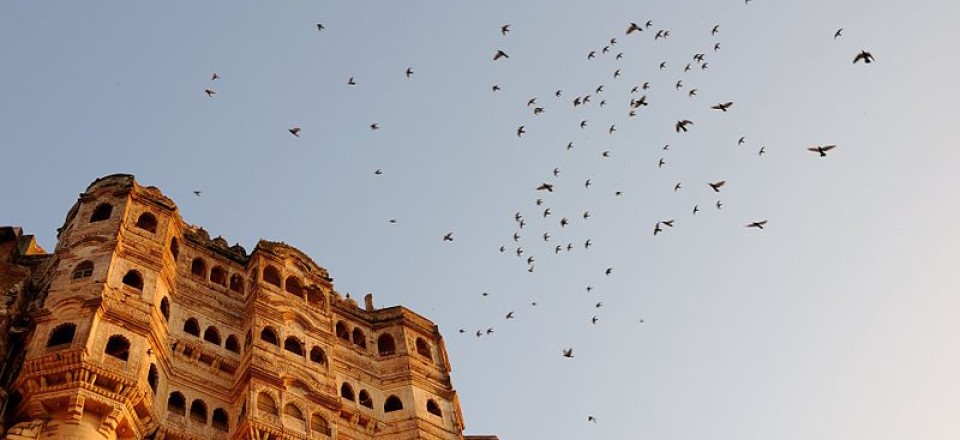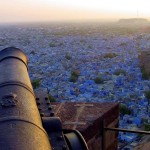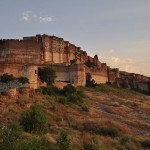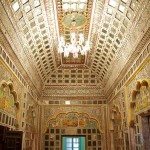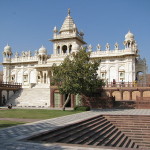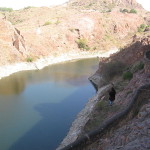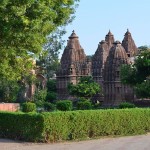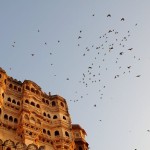A day in Jodhpur
- The blue city
The journey begins.
I am at the gates now, waiting for the rest of my group. They are not as eager as I am – the sun has quite dulled their spirits, but it doesn’t matter. My sister sips water from her endless supply of bottles and I roll my eyes. A long, winding road leads down to the city. It is blue in colour, interspersed with splashes of white and golden.
It lives up to the moniker of the ‘Blue city’. The houses in Jodhpur have been painted blue, possibly to keep them cool even in summer. The blue colour looks dramatic against the unchanging golden desert, almost a tribute to the resilience of the people of Jodhpur, who live in such an unfavourable region. For those less inclined towards physical exertion, an elevator is present, to whisk them off to the fort. Mehrangarh fort is one of those rare forts in India which have an elevator. It seems a fine idea to buy a ticket to the seventh floor, and then amble down to explore the rest of the fort.
“Everyone here?” my friend, Rishav shouts. He has assiduously countered the elevator plan, and has already got the tickets and the audio guides. We bow our heads quickly – he is not the patient sort, and enter the gates of Mehrangarh fort. Jai pol is the name of the entrance, which was built to commemorate the victory of Maharaja Man Singh in a war with Jaipur and Bikaner, in 1806. We pass the last gate – Loha Pol. A wall displays handprints – stark red against the white. These handprints are of the widows who would immortalize their lives before joining their husbands in a funeral pyre, in an act of sati.
The audio guide is superb – quite possibly the best in all the heritage sites in India. As we wander around, I realize that the same can be said of Mehrangarh fort. It is in excellent shape; the structures, buildings and the paintings have been painstakingly preserved. Rudyard Kipling is said to have called it ‘the work of giants’. Looking at the tall fort meeting the impossibly blue sky, I wholeheartedly agree with him.
We are in Jodhpur, one of the largest cities in Rajasthan. The erstwhile capital of Mewar, Jodhpur became the new capital, after Rao Jodha, the ruler shifted it to his namesake city from Mandor.
Mehrangarh fort looks like a part of the rocky terrain it has been built upon. The fort, like many buildings in Rajasthan, seems golden in the sun. We wander through it, mesmerized by the rich decorations, coupled with the impressive commentary on the guide.
Shringar chowk, where Maharajas of Jodhpur would be crowned, lies after the last gate. The surrounding walls are heavily embellished with lattice work, giving it an almost mysterious feel. The galleries, which house a splendid collection of artefacts, lie just beyond the chowk. The gallery is devoted entirely to palanquins, which were litters used by the royalty in the ancient times. Rajat Khasa, the palanquin used by the royal family is quite possibly the best – it is lotus shaped and silver. The museum also has a gallery housing the finest collection of miniature paintings from the school of Mewar.
I love the period rooms in the fort, which look like they are lingering in the memories of the splendour of the Rajputs. Sheesh mahal, the hall of mirrors is especially impressive, with large pieces of mirror, and brightly coloured religious figures. Blue, green, silver, and gold Christmas tree balls are suspended from the ceiling.
Save me God. I’m trying the zipline!
My sister chants the Ramraksha, a protection hymn as we stand on the parapet of Mehrangarh fort. Six zip lines are available at the Flying fox Jodhpur, a zip line tour. Zip lines are metal cables, that connect two points, and one can literally ‘zip’ from one point to another. When my turn comes, I strap on a harness and listen intently as the instructor tells me about the basics of zip lining. It is not exactly rocket science, but looking down at the rock terrain and the steep walls of the fort, I cannot deny a stab of fear. As I push off, embarking on my first zip line, I suppress an irrational desire to scream in terror – and then, as I move forward, the fear vanishes. I let go of myself, feeling the wind rush through my unbound hair and watch the ground, far below. It is exhilarating, utterly liberating. Mehrangarh fort looks even better when you are zipping through the air – wonderfully golden and exotic. I am also rewarded with a stunning vista of the blue city.
The tour ends too soon. I am raring to go on the zip lines again! The parapet of the fort is an excellent place to capture a photo of the blue city, I think, as I click away on my camera.
Missed lunch for other treats.
Lunch is hurried because Rishav wants to explore the Rao Jodha desert park. We enter through the Visitor’s centre and go down the storm water drain. The Visitor’s centre is housed in a sixteenth century gateway, and it has a small shop selling souvenirs, and a cafe. I stop to refill the water bottles. The heat of the day has parched my throat, and despite being dressed in a t-shirt and loose cut offs, I am still hot. Rishav expounds on desert park, while thumbing through the guide to the park. The large, rocky wasteland near Mehrangarh fort was transformed into a desert park, to restore its natural ecology. It is inconceivable to imagine, that any life may survive in this arid, rocky area. But dozens of varieties of flora and fauna flourish, by sheer determination and adaptability for survival.
After a quick tour, we move on to Jaswant Thada, a marble memorial built to honour Maharaja Jaswant Singh, by Sardar Singh. It is made from pale, thin marble that gives the building a pearly translucence in the sunlight. Elaborately carved designs surround its walls, and its serenity is just astounding. Built like a temple, it has also been called as the ‘Taj Mahal of Mewar’ due to the intricacy of its embellishments, and its pure beauty. It is an ode to Rajasthani history and splendour.
Will I become royalty if I stay at Umaid Bhavan?
The stately grandeur of Rajasthan never ceases to amaze me. As I look at Umaid Bhavan Palace, I cannot help but feel awed by its magnificence. One portion of the Palace is the residence of the current Maharaja and his family, one portion is managed by the Taj group as a beautiful hotel, while one portion has been opened to the public as a museum.
The history of the Palace is quite interesting. The Maharaja had commissioned the palace, as a part of the relief efforts when a terrible famine had ravaged Jodhpur. Constructed on a grandiose scale, in an art-deco style, the sandstone palace is one of the world’s largest private residences. The museum has a fabulous collection which includes European crockery and glassware, and clocks and barometers, some in the form of railway locomotives and windmills.
After the split.
The group splits into two – those who wish to push on to Mandore, and those who just want to call it a day. Located just a few kilometres from Jodhpur is the ancient city of Mandore. The old Marwar capital now lies silent and abandoned, but tourists flock to it, enchanted by the red stone memorials and the exquisite gardens. Monkeys are rife here, but in a tacit agreement, they stay away from me. I am particularly enchanted by the Hall of Heroes, which depicts 16 colorfully painted heroes and deities that have been carved from a single piece of stone. We ignore the museum in favour of wandering through the cenotaphs of different rulers, and their female counterparts. A tall, octagonal tower stands nearby, decorated with lattice screens. Women from the royal family could view the public thoroughfare from behind the screens, without exposing themselves. The museum and gardens close soon, and we have to cut our trip short.
The last supper.
Rishav leans towards a hurried meal, but I put my foot down this time. We go to Indique, a rooftop restaurant with an amazing view of the Mehrangarh fort. We try the cheese naan and mutton biryani. Hanwant Mahal, a restaurant near Umaid Bhavan Palace, and Jhankar Choti Haveli, a quaint restaurant with a traditional theme, are also good options. After dinner, my sister shows me her haul. She had mainly shopped on Nai sadak, which leads to the Sardar Market. She has picked up an antique Ganesh statue, bandhani, or tie-and-dye tops, lac bangles and jodhpuri shoes.
Musings.
Our day at Jodhpur is over, but I don’t feel I’ve managed to fully tap into the rhythm of this city. It is not as busy as Jaipur, but is more laid-back and content. History is revered here, and traditions are a source of immeasurable pride. I wish we could have come in December, when the Marwar festival is in full swing, and the people of Jodhpur compete in tonga races and deck themselves in colourful attire, which is a trademark of the state of Rajasthan. I make a resolution to visit the festival next year, and see Jodhpur in its full glory. The last stop on our Rajasthan trip is Pushkar. Later that night, I sit in the window, looking at the ‘Blue city’, asleep and silent; I wait for the dawn to arrive and imagine what Pushkar would be like.
Image credits: Wikimedia commons – Mehrangarh fort: Aiwok, Hendrick Schottle, Sheesh Mahal: Jon Connel, Zip line: Sbohra, Jaswant Thada: Ken Walker, Mandore: Nkansara

